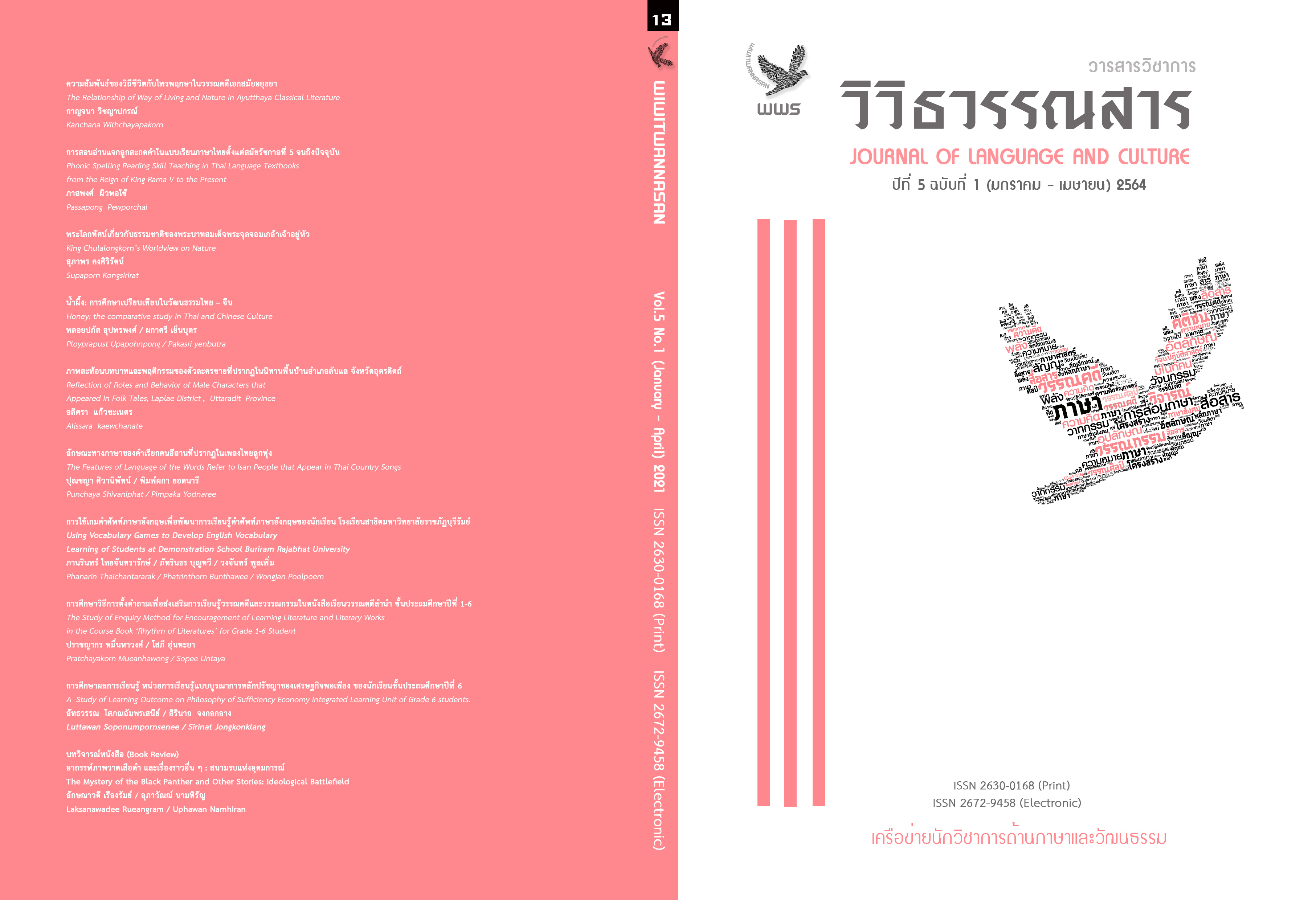ลักษณะทางภาษาของคำเรียกคนอีสานที่ปรากฏในเพลงไทยลูกทุ่ง
Main Article Content
บทคัดย่อ
บทความวิชาการนี้มีวัตถุประสงค์เพื่อวิเคราะห์ลักษณะทางภาษาของคำที่ใช้เรียกคนอีสานที่ปรากฏในเพลงไทยลูกทุ่ง ในด้านโครงสร้างของคำและความสัมพันธ์ทางความหมาย ซึ่งจะช่วยสะท้อนให้เห็นถึงโลกทัศน์ที่มองคนอีสานผ่านบทเพลงได้ โดยข้อมูลที่ใช้ในการวิเคราะห์รวบรวมมาจากคำเรียกคนอีสานในเพลงลูกทุ่ง จำนวน 40 บทเพลง คัดเลือกข้อมูลโดยวิธีเลือกแบบเจาะจง จำนวน 80 คำ ผลการศึกษาพบว่า คำเรียกคนอีสานมีองค์ประกอบจำนวนคำตั้งแต่ 1 - 3 คำ โดยคำเรียกที่มีโครงสร้าง 2 คำ มีจำนวนมากที่สุด ในการวิเคราะห์พิจารณาจากส่วนประกอบของคำและรูปแบบการเรียงคำ ทำให้เห็นว่าโครงสร้างของคำประกอบด้วย 2 ส่วน คือ คำหลัก ทำหน้าที่แสดงความหมายหลักของคำ และ คำขยาย ทำหน้าที่เพิ่มความหมายแก่คำหลัก ในด้านความหมายของคำที่นำมาประกอบเป็นคำเรียก สามารถจัดแบ่งตามกลุ่มที่มาและความหมายได้เป็น 10 กลุ่ม ได้แก่ 1) คำแสดงความเป็นกลุ่มชน 2) คำแสดงเพศสถานะ 3) คำเรียกเครือญาติ 4) ภูมิลำเนา 5) กลุ่มชาติพันธุ์ 6) ชื่อแม่น้ำ 7) เอกลักษณ์ของกลุ่มชน 8) สภาพความเป็นอยู่ 9) สัญลักษณ์ของจังหวัด และ 10) คำเรียกเขตแดน/หน่วยการปกครอง ส่วนผลการวิเคราะห์ภาพสะท้อนทางสังคมและวัฒนธรรมที่สื่อผ่านความหมายของคำเรียกคนอีสานในบทเพลงไทยลูกทุ่ง ปรากฏใน 8 เรื่อง ได้แก่ 1) คนอีสานมีความรักในพวกพ้อง 2) ความรักและความภาคภูมิใจในท้องถิ่นหรือภูมิลำเนาที่ตนอาศัยอยู่ 3) วิถีในการดำเนินชีวิต 4) ศิลปวัฒนธรรมท้องถิ่น 5) ความเชื่อและเคารพในสิ่งศักดิ์สิทธิ์ 6) วิถีชีวิตที่ผูกพันกับน้ำ 7) สภาพสังคมของอีสานที่มีหลากหลายกลุ่มชาติพันธุ์ และ 8) ทัศนคติที่คนอีสานมีต่อการมองของคนอื่นที่ไม่ใช่คนอีสาน
Article Details
ลิขสิทธิ์ของบทความเป็นของวารสาร การพิมพ์ซ้ำจะต้องได้ร้บการอนุญาตจากบรรณาธิการวารสาร
เอกสารอ้างอิง
Chaisomhun, P. (2017). kan tang chưkhrongkan muban chatsan nai changwat Chiang Mai.
(in Thai). [Housing Estates Naming in Chiang Mai]. Journal of Language, Religion and Culture 6(1) January – June.
Chirananthanaphorn, S. and Singnoy, A. (2005). khrongsang thang phasa pum nam kho̜ng
muban changwat uttara dit. (in Thai). The language structure of the village of Uttaradit Province. Journal of Humanities Naresuan University Sciences 2(1) January – June.
Damronglert, C. (1990). Wannakam phleng lukthung : khanopthamniam prapheni
khaniyom læ kandamnœn chiwit kho̜ng chao chonnabot Thai thi prakot nai phleng lukthung Thai tangtæ lang songkhram lok khrang thi so̜ng chonthưng patchuban. (in Thai). [Folk literature: traditions : Values and lifestyle of Thai rural people who appeared in Thai country music since after World War II until now]. Bangkok: Thai Khadi Research Institute Thammasat University.
The Royal Society. (2011). photchananukrom chabap ratchabanthittayasathan.
(in Thai). [Royal Institute Dictionary]. Bankok: Siriwattana Interprint.
Patship, M. (2017). chư mưang nai phumiphak khan to kho̜ng Yipun : khrongsang kham
læ khwammai. (in Thai). [City Naming in Kanto of Japan: Structure and Meaning]. Humanities & Social Sciences 34(2) May – August.
Phongsaphit, A. (2005). saranukrom Thai samrap yaowachon lem yisipsam. (in Thai). [Thai
Encyclopedia for youth, Volume 33]. Bankok: Dansuttha kanphim.
Prasitratthasin, A. (2012). bukkhon samkhan læ khwamkhit lak nai attha sat chattiphan :
kan khaothưng watthanatham doi phan phasa. (In Thai). [Important person and key ideas in ethnographic semantics: Access to culture through language. Bankok: ASP.
Rattanakul, S. (2012) Attha sat bưangton. (in Thai). [Introduction to semantics].
Nakornpathom : Mahidol University.
Singnoy, A. (2008). kham nam prasom : sat læ sin nai kansang kham Thai. (in Thai).
[Science and art in creating Thai words]. Bankok: Chulalongkorn University.
Travel music. (2015). nưaphleng tho̜ngthieo thua Thai. (in Thai). [Lyrics of travel music
around Thailand]. Available from: http://thaisongtour.blogspot.com


